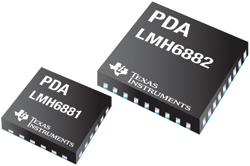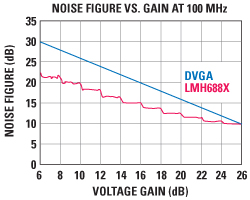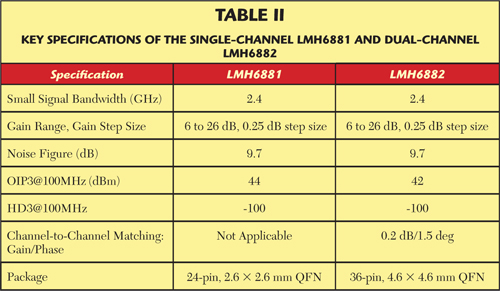
Texas Instruments recently introduced a new class of amplifier, the programmable differential amplifier (PDA), combining the best of fully differential amplifiers (FDA) and digital variable gain amplifiers (DVGA). Designing with high speed operational amplifiers (op amps) is often challenging. Simultaneously achieving high levels of performance across multiple specification requirements such as bandwidth, noise, distortion and impedance can be tricky. Anyone who has had an “op-amp afterthought” design experience will vouch for how tedious it can be to redesign and optimize the signal chain for a different gain value. The 2.4 GHz LMH6881 single-channel PDA and 2.4 GHz LMH6882 dual-channel PDA enable flexible and effortless signal chain design, allowing engineers to use one chip and one design for a broad range of applications.
In order to change the gain with a traditional FDA, an engineer would have to change the value of the external resistors, and then re-optimize the entire design. Additionally, the performance of a balanced signal path system depends on precise matching of the external resistors. Unlike an FDA, the gain control in a PDA is programmable and does not require external resistors, thereby reducing both BOM cost and board space. Furthermore, gain is tightly controlled and performance is improved since well-matched external components are no longer required.

Figure 1 The LMH688x PDAs offers better and more consistent noise and distortion performance over the entire gain range.
Next, consider signal chain design using DVGAs. While the DVGA does allow the same flexible programmable gain control as the PDA, its noise performance is not as good. A typical DVGA does not maintain its noise performance across the entire gain range. As attenuation is reduced, the DVGA’s noise figure increases dB for dB. In contrast, the PDA’s noise figure remains relatively flat across the gain range. Hence, PDAs offer better dynamic range performance across a wider range of gain settings versus traditional DVGAs (see Figure 1 and Table 1).
Both the LMH6881 and LMH6882 offer a gain range from 6 to 26 dB, with a 0.25 dB gain step size. The wide gain range and fine step size enables flexible gain scaling. The gain for these devices can be controlled in either of two modes: a serial mode control through the SPI bus, or a parallel mode control through dedicated pins. The parallel pin control mode provides a simple and quick design approach for engineers who do not want to write code to program their PDAs via the SPI bus. Both PDAs also exhibit high linearity: the single-channel LMH6881 provides an OIP3 of 44 dBm at 100 MHz input frequency, and the dual-channel LMH6882 delivers OIP3 of 42 dBm at 100 MHz. This excellent linearity helps address the demand for ever increasing bandwidth in communications channels.

With an input impedance of 100 ohms, both PDAs can be easily driven from a variety of sources including mixers and filters. Both PDAs support either DC- or AC-coupling, and single-ended (50 ohm) or differential inputs while driving differential output, eliminating expensive and space consuming external baluns. Additionally, the output impedance remains low, allowing the PDAs to drive a wide range of loads with excellent performance.
The versatility and excellent performance of the LMH6881 and LMH6882 over the entire gain range make them a universal design choice for any flexible or scalable platform that would typically use an FDA or DVGA (see Table 2). They address many applications including wireless communications, microwave backhaul, industrial and medical, test and measurement, as well as military and defense equipment. In addition, the LMH6882 offers exceptional channel-to-channel gain matching of 0.2 dB and phase matching of 1.5 degrees, giving it superior image rejection capability for I/Q- or zero-IF sampling applications.

In order to speed up development with the LMH6881 and LMH6882, TI provides a comprehensive support ecosystem. Evaluation modules, reference designs and TINA-TI SPICE models are available, in addition to the E2E support forums for answering high speed amplifier questions. Both the single LMH6881 and dual LMH6882 are available and ready to simplify the way engineers design with differential amplifiers.
Texas Instruments Inc.,
Dallas, TX
www.ti.com/lmh688x
www.ti.com
